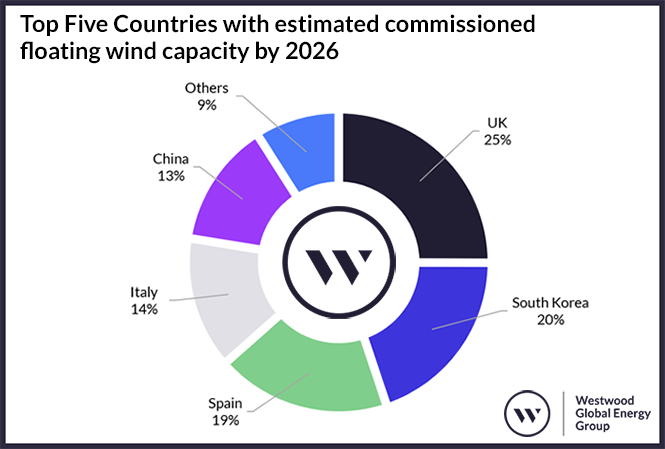About a year ago in the second quarter of 2021, Mainland China became the world’s largest offshore wind market. Mainland China now has 25GW of operational capacity. With this rapid expansion in fixed-bottom offshore wind development, it’s no wonder that Mainland China is also fast-tracking its development in floating wind.
According to Westwood’s WindLogix data, Mainland China is currently ranked fifth globally in terms of installed floating wind capacity to date with 5.5MW. By 2026, Mainland China is estimated to have commissioned a total floating wind capacity of 477MW, 13.4% of the global floating wind capacity, which is forecast to be 3.6GW by 2026.

Top five countries with estimated commissioned floating wind capacity by 2026
Source: WindLogix, Westwood Analysis
Westwood estimates that eight floating wind projects, mostly demonstrations, are likely to be operational in the period between 2021 and 2026. These include the 7.25MW CNOOC Deep Sea Floating, 6.2MW CSSC Fu Yao Floating Demo, 5.5MW CTG Yangxi Shapa Deepwater Floating Demo/Three Gorges Leader, 200MW Hainan PFS-1 Wanning Southeast, 4MW Longyuan Putian Nanri Island Floating Pilot, 15MW Nezzy 2 Demonstrator, 25MW Shanghai Deep & Far Sea Demonstration (Floating) and the 10MW Wenzhou Goldwind Floating Demo.
Key projects and EPC/EPCI contractors
The CTG Yangxi Shapa Deepwater Floating Demo, also known as the Three Gorges Leader, with a capacity of 5.5MW, is the first project to be operational as of early December 2021.
Jointly developed by China Three Gorges Corporation and Ming Yang Smart Energy, the floating wind demonstration, which is located off the coast of Guangdong in Mainland China, comprises a MySE 5.5-158 wind turbine as well as a semi-submersible foundation designed by China Three Gorges Corporation and constructed by Wison Offshore & Marine. The turbine was installed in mid-July 2021 and the infield cables were installed in end-August 2021.
Mainland China’s second floating wind project, the 6.2MW CSSC Fu Yao Floating Demo, is expected to be commissioned in 2022. The project is owned by the turbine OEM CSSC Haizhuang, a subsidiary of China State Shipbuilding Corporation (CSSC). The engineering, procurement, construction and installation (EPCI) of the 6.2MW CSSC Fu Yao Floating Demo was completed in early June 2022 by Poly Changda Engineering.
The 7.25MW CNOOC Deep Sea Floating is currently under construction at the Offshore Oil Engineering yard in Qingdao and estimated to be operational in 2022/2023. When installed offshore, the 7.25MW project will be located in a water depth of 120m in the northern waters of the South China Sea off Guangdong province. Ming Yang Smart Energy is supplying the turbine and CNOOC Rongfeng Energy Co. is the project developer.
Key takeaways
The Guangdong province has the most proposed floating wind projects; four out of the eight targeted to be operational within the next five years, are from this province. Of special note, the Hainan province is moving into offshore wind development which includes floating wind. The Hainan Wanning Southeast 1GW project, which is being developed in two phases, is highlighted as part of the province’s 14th Five Year Plan projects.
Floating wind developers in Mainland China consist of a variety of companies, including traditional offshore wind developers such as China Three Gorges Corporation and Longyuan Power, however in the mix are oil and gas operator China National Offshore Oil Corporation (CNOOC) and supply chain giant China State Shipbuilding Corporation (CSSC).
Ming Yang Smart Energy has taken the lead in supplying the turbines for floating wind projects so far, being involved in two out of three projects near commissioning. Other turbine manufacturers involved include CSSC Haizhuang and Goldwind. With regards to the dynamic cables, companies involved in supplying these to the floating wind projects include Orient Cable and Hengtong Cable.
Next steps
A key project in the 2022 plans of the Ministry of Science and Technology of the People’s Republic of China, is to research 10MW floating wind turbines. Mainland China is making strides in floating wind, which includes increasing the number of demonstrations, commercialising floating wind projects and increasing the turbine rating for floating wind projects. Will Mainland China dominate in floating wind like it has for fixed-bottom wind? That is indeed a possibility.
Ruth Chen, Senior Analyst – Offshore Wind
[email protected]




